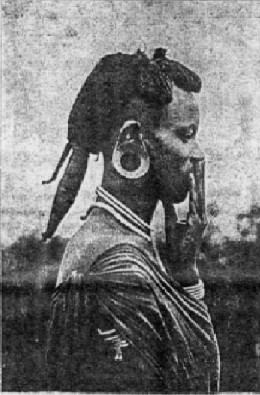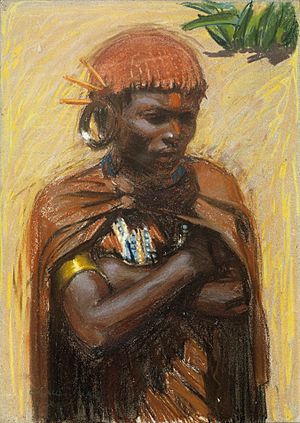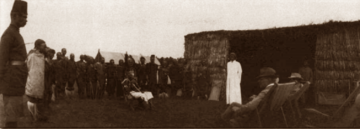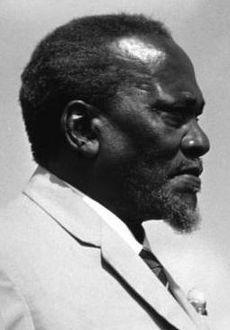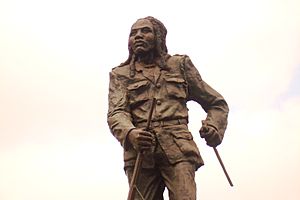Kikuyu people facts for kids
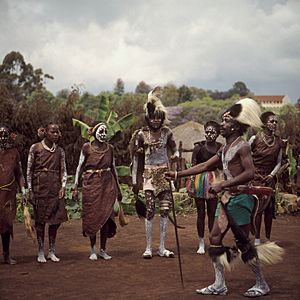 |
|
| Total population | |
|---|---|
| 8,148,668 | |
| Regions with significant populations | |
| Kenya | |
| Languages | |
| Gĩgĩkũyũ, Kiswahili and English | |
| Religion | |
| Christianity, Agikuyu Religion, Islam and Irreligious | |
| Related ethnic groups | |
| Embu, Meru, Mbeere, Kamba, Sonjo and Dhaiso |
| Person | MũGĩkũyũ |
|---|---|
| People | AGĩkũyũ |
| Language | Gĩkũyũ |
| Country | Bũrũrĩ Wa Gĩkũyũ |
The Kikuyu (also known as Agĩkũyũ or Gĩkũyũ) are a large group of people from Central Kenya. They are part of the Bantu family. With over 8 million people in 2019, they are the biggest ethnic group in Kenya. They make up about 17% of Kenya's total population.
The name Kikuyu comes from the Swahili word for Gĩkũyũ. The word Gĩkũyũ comes from mũkũyũ, which means "sycamore fig tree". So, Agĩkũyũ in the Kikuyu language means "Children Of The Big Sycamore". Another name, Nyũmba ya Mũmbi, means "House of the Potter" or "Creator". This name includes the Embu, Gikuyu, and Meru people.
History of the Kikuyu People
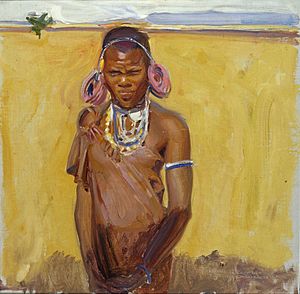
Where the Kikuyu Came From
The Kikuyu people belong to the Northeastern Bantu group. Their language is very similar to the languages of the Embu and Mbeere people. They mostly live near Mount Kenya.
Experts are not fully sure where the Northeastern Bantu speakers came from after the big Bantu expansion. Some think the Kikuyu arrived in the Mount Kenya area from places further north and east. Others believe the Kikuyu, Embu, Meru, Mbeere, and Kamba moved into Kenya from areas further north.
Archaeological findings suggest they arrived north of Mt. Kenya around the 3rd century. They were part of a larger group called Thagicu. By the 6th century, a Kikuyu community was living at Gatung'ang'a in Nyeri. The Agikuyu settled in their current homeland around Mt. Kenya by the 13th century.
Life Before European Arrival
Before the East Africa Protectorate was set up in 1895, the Agĩkũyũ had kept their land and power for many years. They had never been conquered by outsiders. Before the British arrived, Arabs involved in the Indian Ocean slave trade passed by the southern edges of Agĩkũyũ land. However, the Agĩkũyũ did not practice slavery. Arabs who tried to enter Agĩkũyũ land were usually killed.
The Agĩkũyũ expanded their land by buying it, forming partnerships, and marrying into other groups. They were known as excellent farmers and smart business people. Besides farming and trade, they also had small industries. They built bridges, made strings, drew wire, and created iron chains. The Agĩkũyũ also had a strong sense of justice (kĩhooto).
Social and Political Life
The Agĩkũyũ nation was divided into nine clans. Each clan believed they came from a single female ancestor, a daughter of Mumbi. These clans did not stay in one area; they lived side by side. Some clans had a recognized leader, while others did not.
However, the real power was held by a council of elders for each clan. Each clan then sent its council leader to a main council of elders for the whole community. This overall council, representing all clans, was led by a headman or the nation's spokesperson.
The Colonial Period (1888–1963)
The traditional way of life for the Agikuyu changed when the British arrived around 1888. British explorers had visited the area before the "Scramble for Africa". Now, people wanted to create a colony there because of the rich farmland.
At first, relations were peaceful. But soon, problems started. Waiyaki Wa Hinga, a leader in the southern Agikuyu area, had signed a treaty with Frederick Lugard of the Imperial British East Africa Company. However, Waiyaki burned down Lugard's fort in 1890.
The British East Africa Company faced money problems. So, on July 1, 1895, the British government took direct control. They created the East African Protectorate. In 1902, they opened the fertile highlands to European settlers. The Agikuyu were upset by the many new settlers. They decided to punish anyone from their own group who worked with the colonial government.
When fights over land happened between white settlers and the Agikuyu, the settlers often used Maasai tribesmen and colonial soldiers to fight for them. The Maasai had a history of conflict with the Agikuyu, so they were willing to help. The Agikuyu often lost these fights because their weapons were not as good. Since fighting did not work, the Agikuyu turned to political ways to solve their problems.
Kenya became an important base for the British during the First World War (1914-1918). They wanted to capture German colonies to the south. The British needed many porters to carry supplies far into the country. The Carrier Corps was formed, and over 400,000 Africans were part of it. This experience helped many Africans become more interested in politics.
After the war, Africans gained new experiences. The creation of the white-controlled Kenya Crown Colony led to much political activity in the 1920s. The "Young Kikuyu Association" (later called the "East African Association") was started in 1921 by Harry Thuku. This group helped many Kikuyu feel a sense of nationalism and encouraged peaceful protest. Thuku was exiled in 1922.
In 1924, the Kikuyu Central Association (KCA) was formed to continue Thuku's work. From 1924, the KCA, with Jomo Kenyatta as its Secretary General, worked to unite the Kikuyu. The KCA sent Kenyatta to England in 1924 and again in 1931. He went to share their complaints against the colonial government.
By the 1930s, about 30,000 white settlers lived in Agikuyu country. They gained political power because they helped the economy. Over a million Kikuyu people already lived there. Most had been pushed off their land by the settlers and worked as traveling farmers. To protect their own interests, the settlers banned coffee farming by Africans. They also introduced a "hut tax" and gave less land to workers. Many Kikuyu moved to cities because they could no longer make a living from the land.
In the Second World War (1939–1945), Kenya became a key military base. Agikuyu soldiers who fought in the war as part of the King's African Rifles learned a lot. The war helped grow African nationalism and changed their views of Europeans. In 1944, Harry Thuku founded the Kenya African Study Union (KASU), which included many ethnic groups.
Road to Independence (1945–1963)
In 1946, KASU became the Kenya African Union (KAU). This group demanded access to land owned by white settlers. The KAU was mainly led by the Kikuyu ethnic group. In 1947, Jomo Kenyatta, who had led the Kikuyu Central Association, became president of the KAU. He pushed for more political power for native Kenyans.
The KAU did not achieve many changes from the colonial government. This led younger, more active leaders to take charge. These leaders came from trade unions, from farmers on settler lands, and from KAU groups in Nairobi and Kikuyu areas.
By 1952, under Field Marshal Dedan Kimathi, the Kenya Land and Freedom Army (also known as Mau Mau) started a full revolt. They fought against the colonial government, the settlers, and their Kenyan allies. The Mau Mau were fighting for Kenya's complete independence. This war was a very serious crisis for Britain's African colonies.
The capture of rebel leader Dedan Kimathi on October 21, 1956, marked the end of the Mau Mau Uprising's military campaign. However, the state of emergency lasted until 1959. This conflict helped set the stage for Kenya's independence in December 1963.
Kikuyu in Modern Kenya (1963–Present)
Since Kenya became a republic in 1963, the Agikuyu have been an important part of the Kenyan nation. They continue to help build their country as citizens of Kenya. However, some Kenyans sometimes feel upset about what they see as the Kikuyu's better economic position. This can sometimes lead to political violence, as seen in the Kenyan elections of 1992, 1997, and 2007.
Kikuyu Culture
Language of the Kikuyu
The Gĩkũyũ people speak the Gĩkũyũ language as their native tongue. It is part of the Bantu language family. Many Gĩkũyũ also speak Swahili and English. These are the two official languages of Kenya.
The Gĩkũyũ are closely related to other Bantu groups like the Embu, Meru, and Akamba people. This is partly due to marriages before colonization. Gĩkũyũ people from Kiambu and Nyeri districts are also related to the Maasai because of past intermarriages. The Gĩkũyũ people between Thika and Mbeere are close to the Kamba people, whose language is similar to Gĩkũyũ.
Because of these connections, the Gĩkũyũ people who have kept most of their original heritage live around the Kirinyaga and Murang'a regions of Kenya. Many believe the Murang'a district is where the Gĩkũyũ people first came from.
Kikuyu Stories and Books
Before 1888, Agikuyu literature was mainly spoken stories, or folklore. Famous stories include The Maiden Who Was Sacrificed By Her Kin and The Lost Sister.
When European missionaries arrived in 1888, they learned the Kikuyu language. They started writing it down using a changed Roman alphabet. The Kikuyu people were very open to missionaries and European education. They had more chances to go to school and get involved in the new money economy and political changes.
Because of this, there are famous Kikuyu writers like Ngũgĩ wa Thiong'o and Meja Mwangi. Ngũgĩ wa Thiong'o's books include Caitani Mutharabaini (1981) and Matigari (1986). His book Murogi wa Kagogo (2006) is the longest known Kikuyu language novel. It has been translated into over thirty languages.
Music of the Kikuyu
Traditional Kikuyu music existed for many generations until 1888, when colonialism changed their lives. Before 1888 and into the 1920s, Kikuyu music included styles like Kibaata, Nduumo, and Muthunguci. As cities grew and life became more modern, some cultural knowledge was lost. This included how to play the mũtũrĩrũ, which is a type of flute.
Today, music and dance are very important parts of Kikuyu culture. There is a strong Kikuyu music industry, making both religious and non-religious music. They use their traditional pentatonic scale and also Western music styles.
Kikuyu Films and TV
Kikuyu cinema and film making are quite new for the Agikuyu people. They only became popular in the 21st century. In the 20th century, most Agikuyu watched films from the West. Popular Kikuyu films include comedies like the Machang'i and Kihenjo series. Recently, Kenyan TV channels have grown a lot. Now, there are channels that show programs in the Kikuyu language.
Kikuyu Food
Typical Agĩkũyũ food includes Yams and sweet potatoes. They also eat Gītheri (maize and beans, after corn came to Africa). Mūkimo is mashed green peas and potatoes. Kīmitū is mashed beans and potatoes. Irio is mashed dry beans, corn, and potatoes. Mūtura is a sausage made from goat intestines, meat, and blood. Ūcūrū is a fermented porridge made from corn, millet, or sorghum flour. They also enjoy roast goat, beef, chicken, and cooked green vegetables like collards, spinach, and carrots.
Kikuyu Religion
Historically, Gĩkũyũs followed their own traditional faiths. Today, most are Christians, belonging to different churches. Some also combine Christian beliefs with older traditions. A small number of Kikuyu practice Islam, mainly due to trade with Arabs, Indians, and Persians.
A small group of about 60 Kikuyu people in Kusuku practiced Judaism in 2015. They follow a form of Judaism similar to Conservative Judaism. However, they are not officially recognized by any larger Jewish group.
Religious and Cultural Differences
In April 2018, the Presbyterian Church of East Africa decided to ban its members from a Kikuyu cultural practice called Mburi cia Kiama. This caused problems among followers in the Mount Kenya region. Mburi cia Kiama involves sacrificing goats and advising men on how to become respected elders. After this process, men join different kiamas (groups). In these groups, they receive advice on marriage, Kikuyu culture, and community duties. Church members were told to stop this cultural practice or leave the church.
See also
 In Spanish: Kĩkũyũ para niños
In Spanish: Kĩkũyũ para niños


